Neurodiversity information for parents and young people
Congratulations on your pregnancy. We hope you are feeling strong and well. Lots of women have aches and pains while they are pregnant. We hope you do not experience these but it is good to be aware of the changes that are happening to your body.
Below, we offer advice and easy exercises to help keep you comfortable.
Click on the link for a video explaining exercises during pregnancy:
1. Caring for your back
Lower back pain is common during pregnancy for a number of reasons.
- Hormones cause structures throughout the body to relax and soften which reduces stability.
- The ‘six pack’ tummy muscles, which normally help to support the spine, separate to allow the baby to grow.
- Weight gain and changes to how you stand can alter your centre of gravity.
Everyday activities
It is wise to take care of your back and make sure that the activities you carry out frequently are done in comfortable, well-supported positions. Here are some useful tips.
Remember: if it is painful, stop or change your activity.
- Avoid staying in one position for a long time.
- Change position regularly.
- Ensure your workstation is set up correctly.
- Wear supportive shoes, such as trainers.
- Avoid heavy lifting. Use a rucksack or backpack to carry heavy things.
- Avoid twisting movements, for example, when getting in and out of the car or when carrying a toddler on one hip.
- Slow down and pace your activities.
- Heat or ice packs can help to relieve back pain.
- When sitting, sit with your bottom well back in the chair so that your back is supported. You may find a small cushion or a rolled towel placed in the small of the back, and using a footstool, helps you to sit more upright.
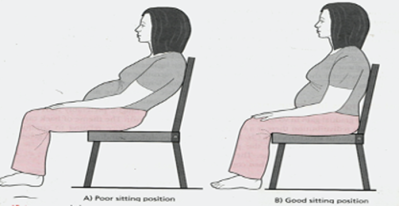
Getting in and out of bed
Here are some suggestions which may make getting in and out of bed easier and more comfortable.
Remember: keep these movements small and controlled.
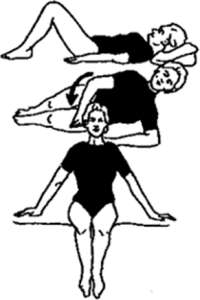
To get into bed:
- Sit on the bed and ‘brace’ your tummy muscles. Do this by taking a breath in through your nose and as you breathe out, gently draw your belly button towards your spine.
- Lower down onto your side. Then, keeping your knees together, bring your legs up as one.
- Once you are on your side, slowly turn the knees, hips and body in one block and gently roll over onto your back.
- To adjust your position, push up with your hands and feet.
To get out of bed:
- Again, ‘brace’ your tummy muscles (as above).
- Keeping everything together, gently roll over onto your side.
- As you put your feet over the side of the bed, push yourself up with your arms.
2. Pelvic floor
The pelvic floor muscles work as a sling. They run from the base of your spine (the coccyx) to the pubic bone at the front of the pelvis.
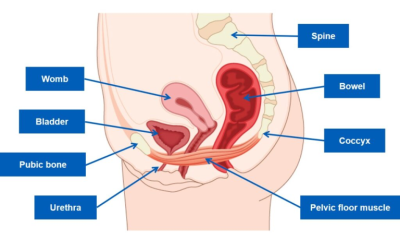
The job of these muscles includes:
- helping control when you wee and poo
- supporting your bladder, bowel and womb
- providing stability for the joints in the pelvis and lower back
- sexual activity and enjoyment
- supporting your growing baby.
There are 3 openings in the pelvic floor muscles. These are for the urethra (the front passage which drains urine from the bladder), the vagina (birth canal) and the anus (back passage).
During pregnancy, the increasing weight of your baby may weaken your pelvic floor muscles. You may get leaking of urine, especially when coughing, sneezing or lifting something.
![]()
Pelvic floor exercises
These exercises can be done anywhere, any time and in any position. However, doing them when lying down or sitting will be easier than when standing.
Remember, with these exercises, try to isolate your pelvic floor as much as possible. To help this:
- avoid squeezing your legs together
- avoid tightening your buttocks
- avoid holding your breath.
Firstly, imagine a zip running from the back to front between your legs. Then:
- SLOW contractions
- Take a breath in.
- As you breathe out, firmly tighten around your back passage as if you are stopping yourself from passing wind.
- Continue to draw that same contraction forwards and upwards as if you are doing up a zip between your legs.
- Once you feel the pelvic floor muscles lifting, hold onto this contraction.
- As you hold, keep breathing and count steadily for up to 10 seconds.
Then slowly release all the way. - Rest for 5 seconds.
- Repeat 10 times, 3 times a day.
- FAST contractions
-
Lift your pelvic floor muscles up as tight as you can and hold for 1 second.
-
Release all the way.
-
Repeat 10 times, 3 times a day.
Practice this same exercise before a sneeze, cough or lift.
-
These exercises are for life! The ‘Squeezy App’ may help you get into a routine.
3. Perineal massage
The perineum is the area of skin and muscles between the vagina and anus. The perineum can sometimes tear during a vaginal birth.
‘Perineal massage’ involves massaging the perineum to soften the area and prepare it to stretch more easily during the birth. Evidence has shown that this helps to reduce the risk of tearing and for the need for episiotomy (a cut in the perineum, done by a nurse or doctor during labour, to make the vagina wider).
When to start
You can start perineal massage anytime from 34 weeks of pregnancy. We recommend it is done at least 3 to 4 times a week, for 5 to 10 minutes each time.
How to do the massage correctly
After a bath or shower, find a comfortable position. Try sitting down with one foot supported on a stool while leaning back against something, or squatting against a wall.
- Wash your hands.
- For lubrication, use unscented perineal massage oil, olive oil, evening primrose oil or sunflower oil. Do not use baby oil, mineral oil or petroleum-based products.
- Place one or both thumbs about 5cm into the vagina and press downwards on the back wall towards the rectum so that you can feel the stretch of the muscles around the vagina.
- This should not hurt and will help you recognise the feeling when you baby is ready to be born.
- Once you have this downward pressure, use your thumbs to sweep from side to side in a rhythmic ‘U’ movement.
- Focus on relaxing your pelvic floor muscles throughout the massage to help stretch the perineum.
- The perineum may feel tight when you first begin but should become easier.
- If your partner is performing the massage, it will be easier for them to use their index fingers rather than their thumbs. Let them know how much pressure to apply.
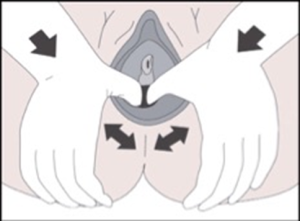
Do not perform perineal massage:
- if you think your waters may have broken
- if you have herpes, vaginal thrush or a vaginal infection.
![]()
4. Bracing your abdominals – ‘The bump lift’
The deepest abdominal muscles act like a corset and help to support your back and pelvis. The ‘bump lift’ involves bracing these deep muscles.
It is important to practise this exercise in different positions.
How to do the exercise
- Take a breath in, feeling your ribcage expand and your tummy rise.
- As you breathe out, gently draw your belly button towards your spine, feeling your bump ‘lift’.
- Hold onto this contraction as you relax your breathing.
- This should be repeated little and often throughout the day, but particularly before moving or changing position.

Remember: It is very important to use the deep abdominal and pelvic floor muscles in everyday activities. This will also help to reduce the strain on your back.
- Hold them in when walking.
- Brace when lifting.
- Engage when transferring or changing position.
5. General exercise
Pregnancy is a good time to improve your fitness. Regular mild to moderate exercise is good for you and your baby. However, do not take up strenuous exercise if you were not active before your pregnancy.
If you are not used to exercising, you may wish to start with some low impact activities such as walking, swimming or using an exercise bike. You could also include general strength and core stability exercises.
Start with 15 minutes of continuous exercise four times per week. Gradually increase to 30 minutes of continuous exercise every day.
Avoid any activity that causes significant discomfort.
Exercising tips
- Drink plenty of water to avoid dehydration.
- Work to your own level and avoid getting too hot or breathless.
- Listen to your body and stop immediately if you feel unwell.
- If you were running before becoming pregnant it is fine to continue. However, as your baby develops you may need to work at a lower intensity.
- Rapid twists and changes of direction may cause pain.
- If working out in a club, always tell the fitness and gym instructors that you are pregnant so they can give you alternative exercises and show you how to use machines correctly.
- Avoid competitive or contact sports because they may be risky.
- Conditions that are hot, humid, at high altitude or low depth are generally not suitable for pregnant women.
- Avoid breaststroke as this may aggravate back or pelvic pain.
- Avoid long periods of lying on your back after 16 weeks of pregnancy. This is because, in this position, the weight of the baby can press on certain blood vessels.
Relaxation
Try to have 10 minutes of relaxation every day.
- Settle in a well-supported position, for example, lying on your side.
- Take a breath in and, as you breathe out, gently slide your shoulders down and away from your ears.
- Feel your neck lengthen and your chest open.
- Fully stretch your fingers and toes.
- As you release, feel your hands and feet go heavy.
- Focus on your breathing. Breathe slowly in through the nose and out through the mouth, allowing your tummy to rise and fall.
- Try to clear your mind and enjoy that relaxed feeling as long as possible.
6. Common problems during pregnancy
Constipation
Constipation is common in pregnancy, affecting up to half of pregnant women. This is due to the progesterone hormone relaxing the smooth muscle in the digestive system. This makes food pass through more slowly. This can be made worse by the weight of the growing uterus on the back passage (rectum).
As well as daily exercise, there are some simple steps that can help.
- Drink plenty of fluids. Aim for about 1.5 to 2 litres of water a day. You may need more on a hot day or if you are exercising.
- Eat lots of fruit and vegetables. Aim for at least 5 portions a day.
- Eat plenty of fibre. This is high in foods such as beans and lentils, wholemeal bread and brown rice, oats and dried fruit.
- Aim to have your breakfast within 30 minutes of waking up. This will often trigger a natural reflex causing an urge to open your bowels 30 to 60 minutes later.
- Do not ignore the urge to open your bowels for more than 10 minutes. During this time, more water is absorbed from your poo. This can make it more difficult to pass.
- The best position to open your bowels is shown in the diagram below.
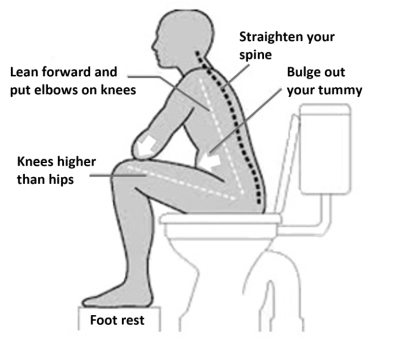
Leg Cramps
Leg cramps are often due to the changes in your body chemistry and changing pressures in the abdomen. Wearing high-heeled shoes or sitting cross-legged can make cramps worse.
Some women find that the following just before bedtime can help to relieve leg cramps:
- circle ankles, 10 times each way
- calf stretches
- heat and massage to the calf muscles.
Numb fingers and hands
Some women get numb fingers and hands during pregnancy. This is due to the extra fluid in the body which increases pressure at the wrist. This may happen at night or first thing in the morning. Some helpful tips include:
- wear wrist supports at night
- sleep with the arm slightly raised
- resting your hands and wrists in cool water or cooling them with ice packs
- gentle range of movement exercises.
The Chartered Society of Physiotherapists website has information and exercises for carpal tunnel syndrome.
Swollen ankles and varicose veins
Ankles and feet often swell a little in pregnancy. This is because your body is holding more water than usual. You may notice this more towards the end of the day when the extra fluid gathers in the lowest parts of the body, especially if the weather is hot or if you have been standing a lot.
The gradual swelling is not harmful to you or your baby, but it can be uncomfortable. The following can help to reduce the swelling.
- Briskly move your feet up and down for 30 seconds every hour.
- When sleeping, lie on your side with your legs slightly raised.
- Avoid standing for long periods of time.
- Consider support tights.
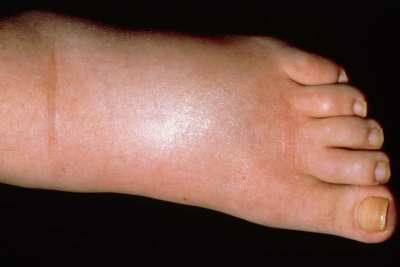
Tell your midwife or doctor straight away if you notice any of the following symptoms. These may be signs of more serious problems:
- swollen ankles and/or fingers
- puffy face
- headaches
- seeing flashing lights.
![]()
Rib flare
Rib flare is the name given to discomfort over your lower ribs. It is due to your growing baby pushing your ribs out from their normal position. To help ease the symptoms you may wish to try the following.
- Changing your position regularly.
- Avoid sitting on low chairs or in positions that bring your ribs closer to your pelvis.
- Heat can be very soothing. Try a warm bath or shower, or a hot water bottle placed over the ribs (but never the bump).
- Gentle stretches can help. Follow these steps:
- Sit up and bend your upper body sideways.
- Bend away from the side of the pain.
- Raise the arm on the same side as the pain above your head.
- Hold for a few minutes, taking deep breaths in and out.
- Relax. Then return to normal.
Changes in your mood
The hormonal changes in pregnancy may lead to emotional ups and downs and sometimes forgetfulness. After the birth, these problems usually disappear gradually.
Get help from your midwife or GP if you are worried about coping with these emotional changes or if your symptoms do not get better.
More information
- The Pelvic, Obstetric and Gynaecological Physiotherapy website has advice on issues such as:
- hip and back pain
- tummy muscle separation
- incontinence
- recovery.
- For more information about pelvic floor health, go to:
- Squeezy app to help train your pelvic floor
- getUBetter app for digital support on women’s pelvic floor health
- NHS video on pelvic floor exercises:

Contact information
Physiotherapy
